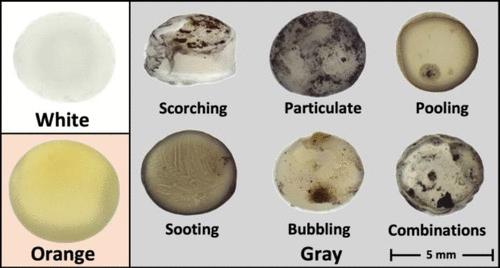热塑性的不同形式:从M/V X-Press珍珠舰火灾中吸取的教训
IF 6.7
Q1 ENGINEERING, ENVIRONMENTAL
引用次数: 10
摘要
2021年5月下旬,M/V X-Press Pearl集装箱船在斯里兰卡科伦坡海岸18公里处抛锚时起火,溢出了700多亿块塑料或“nurdles”(约1680吨),散落在该国海岸线上。暴露在燃烧、高温、化学品和石油产品中,导致了从没有明显影响到碎片的明显连续变化,这与之前在海滩上发现的熔化和燃烧塑料(热塑性塑料)的报告一致。在这一连续体的中间,nurdle变色,但似乎保留了它们的前形态,类似于在环境中风化的nurdle。我们对船起火5天后在海滩上收集的变色nurdles的物理和表面特性进行了详细调查,这些nurdles在抵达岸上24小时内。塑料的颜色是最显著的特征:白色代表与事故变化最小的nurdles,橙色代表含有暴露在高温下形成的抗氧化降解产物的nurdle,灰色代表部分燃烧的nurdls。我们的颜色分析表明,从船上释放的这部分塑料不是一个连续体,而是分成不同的组。大火使灰色的nurdles烧焦,夹杂着颗粒和熔化的塑料池,并覆盖着烟灰,这代表了部分热塑性塑料,一种新型的热塑性材料。横截面显示,热和火引起的变化是表面的,表面更亲水,但内部相对未受影响。这些结果为响应者提供了及时和可操作的信息,以重新评估清理终点,监测这些泄漏的nurdles的复发,评估泄漏的nuddles对当地生态系统的短期和长期影响,并管理泄漏的恢复。这些发现强调了部分燃烧的塑料(热塑性塑料)是一种塑料污染,尽管全球塑料燃烧的频率很高,但仍有待充分探索。本文章由计算机程序翻译,如有差异,请以英文原文为准。

Divergent Forms of Pyroplastic: Lessons Learned from the M/V X-Press Pearl Ship Fire
In late May 2021, the M/V X-Press Pearl container ship caught fire while anchored 18 km off the coast of Colombo, Sri Lanka and spilled upward of 70 billion pieces of plastic or “nurdles” (∼1680 tons), littering the country’s coastline. Exposure to combustion, heat, chemicals, and petroleum products led to an apparent continuum of changes from no obvious effects to pieces consistent with previous reports of melted and burned plastic (pyroplastic) found on beaches. At the middle of this continuum, nurdles were discolored but appeared to retain their prefire morphology, resembling nurdles that had been weathered in the environment. We performed a detailed investigation of the physical and surface properties of discolored nurdles collected on a beach 5 days after the ship caught fire and within 24 h of their arrival onshore. The color was the most striking trait of the plastic: white for nurdles with minimal alteration from the accident, orange for nurdles containing antioxidant degradation products formed by exposure to heat, and gray for partially combusted nurdles. Our color analyses indicate that this fraction of the plastic released from the ship was not a continuum but instead diverged into distinct groups. Fire left the gray nurdles scorched, with entrained particles and pools of melted plastic, and covered in soot, representing partial pyroplastics, a new subtype of pyroplastic. Cross sections showed that the heat- and fire-induced changes were superficial, leaving the surfaces more hydrophilic but the interior relatively untouched. These results provide timely and actionable information to responders to reevaluate cleanup end points, monitor the recurrence of these spilled nurdles, gauge short- and long-term effects of the spilled nurdles to the local ecosystem, and manage the recovery of the spill. These findings underscore partially combusted plastic (pyroplastic) as a type of plastic pollution that has yet to be fully explored despite the frequency at which plastic is burned globally.
求助全文
通过发布文献求助,成功后即可免费获取论文全文。
去求助
来源期刊

ACS Environmental Au
环境科学-
CiteScore
7.10
自引率
0.00%
发文量
0
期刊介绍:
ACS Environmental Au is an open access journal which publishes experimental research and theoretical results in all aspects of environmental science and technology both pure and applied. Short letters comprehensive articles reviews and perspectives are welcome in the following areas:Alternative EnergyAnthropogenic Impacts on Atmosphere Soil or WaterBiogeochemical CyclingBiomass or Wastes as ResourcesContaminants in Aquatic and Terrestrial EnvironmentsEnvironmental Data ScienceEcotoxicology and Public HealthEnergy and ClimateEnvironmental Modeling Processes and Measurement Methods and TechnologiesEnvironmental Nanotechnology and BiotechnologyGreen ChemistryGreen Manufacturing and EngineeringRisk assessment Regulatory Frameworks and Life-Cycle AssessmentsTreatment and Resource Recovery and Waste Management
 求助内容:
求助内容: 应助结果提醒方式:
应助结果提醒方式:


